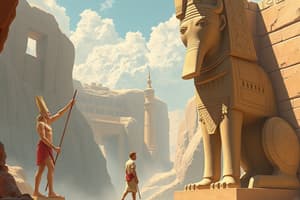Podcast
Questions and Answers
What significant shift occurred in Egypt’s governance during the 1st millennium BC?
What significant shift occurred in Egypt’s governance during the 1st millennium BC?
- Egypt focused solely on agricultural development.
- Egypt became a democracy for the first time.
- Foreigners seized control and assumed the position of pharaoh. (correct)
- The pharaohs regained their absolute power.
Why did animal cults become increasingly popular in 1st millennium BC Egypt?
Why did animal cults become increasingly popular in 1st millennium BC Egypt?
- They were a newer form of worship introduced by foreigners.
- They represented a shift away from traditional Egyptian worship.
- Animal cults were mandated by Ptolemaic rulers.
- They were seen as a reaction to uncertainty and foreign influence. (correct)
What role did Isis play in the context of changing beliefs in Egypt?
What role did Isis play in the context of changing beliefs in Egypt?
- Isis was primarily worshiped by the ruling Greek class.
- Isis gained popularity as a goddess of protection, magic, and personal salvation. (correct)
- Isis emerged as a goddess of justice and law.
- Isis became less important as pharaonic power waned.
What cultural change characterized Egypt under the Ptolemaic dynasty?
What cultural change characterized Egypt under the Ptolemaic dynasty?
How did the perception of Egyptian deities change during Hellenistic influence?
How did the perception of Egyptian deities change during Hellenistic influence?
What effect did the transition of Egypt into a Roman province have on local religious practices?
What effect did the transition of Egypt into a Roman province have on local religious practices?
What was a notable characteristic of the statutes created during the later periods in Egypt?
What was a notable characteristic of the statutes created during the later periods in Egypt?
Which deity was particularly emphasized in Roman Egypt due to its appeal across cultures?
Which deity was particularly emphasized in Roman Egypt due to its appeal across cultures?
Which aspect of Egyptian civilization does climate change potentially influence, according to modern interpretations?
Which aspect of Egyptian civilization does climate change potentially influence, according to modern interpretations?
What is a prominent theme in the worship practices at Egyptian temples?
What is a prominent theme in the worship practices at Egyptian temples?
In which way did Egyptian mythology influence other cultures?
In which way did Egyptian mythology influence other cultures?
Which period is marked by notable transitions within ancient Egyptian culture?
Which period is marked by notable transitions within ancient Egyptian culture?
Which of the following accurately describes the role of deities in ancient Egyptian religion?
Which of the following accurately describes the role of deities in ancient Egyptian religion?
What was a significant influence of ancient Egyptian practices on neighboring cultures?
What was a significant influence of ancient Egyptian practices on neighboring cultures?
Which best describes temple worship practices in ancient Egypt?
Which best describes temple worship practices in ancient Egypt?
What was one of the primary purposes of mummifying animals in ancient Egypt?
What was one of the primary purposes of mummifying animals in ancient Egypt?
Which aspect best describes the impact of the Amarna Period on modern interpretations of ancient Egyptian society?
Which aspect best describes the impact of the Amarna Period on modern interpretations of ancient Egyptian society?
What was a significant aspect of temple worship practices during the later New Kingdom?
What was a significant aspect of temple worship practices during the later New Kingdom?
How did the Amarna Period influence other cultures in its time?
How did the Amarna Period influence other cultures in its time?
Which of the following best characterizes the mythology and deities associated with the Amarna Period?
Which of the following best characterizes the mythology and deities associated with the Amarna Period?
What historical transition does the Amarna Period signify in ancient Egyptian history?
What historical transition does the Amarna Period signify in ancient Egyptian history?
Which description aligns most closely with temple worship practices during the Amarna Period?
Which description aligns most closely with temple worship practices during the Amarna Period?
What impact did the Amarna Period's emphasis on Aten have on neighboring cultures?
What impact did the Amarna Period's emphasis on Aten have on neighboring cultures?
Which of the following best illustrates the modern scholarly views on the Amarna Period?
Which of the following best illustrates the modern scholarly views on the Amarna Period?
Flashcards are hidden until you start studying
Study Notes
Egyptian Religious Evolution in the 1st Millennium BC
- Egypt's power diminished in the 1st millennium BC, leading to foreign conquests and a decline in the authority of the pharaoh.
- Popular piety increased, reflecting a shift towards individualistic spiritual practices amid political instability.
- Animal cults emerged as a common form of worship, likely in response to uncertainty and foreign dominance.
Rise of Isis
- Isis became a central figure in Egyptian religion, noted for her protective qualities, magic, and personal salvation.
- Her significance increased, establishing her as the most important goddess in the Egyptian pantheon during this period.
Hellenistic Influence
- Egypt transitioned into a Hellenistic kingdom under the Ptolemaic dynasty (305–30 BC), where Greek rulers embraced Egyptian religious traditions.
- Rulers rebuilt temples and identified local deities with their Greek counterparts, creating a fusion of beliefs.
Creation of Serapis
- Serapis was a syncretic god that merged attributes of Osiris and Apis with Greek deities, gaining popularity among the Greek populace.
- The Ptolemaic period saw the persistence of distinct Egyptian religious practices, despite the integration of Greek elements.
Roman Rule and Continuity
- After Roman annexation in 30 BC, Ptolemaic kings were replaced by remote emperors, yet the core of Ptolemaic beliefs persisted.
- The cult of Isis expanded outside of Egypt, attracting followers in the broader Roman Empire, reflecting the enduring appeal of Egyptian deities.
Studying That Suits You
Use AI to generate personalized quizzes and flashcards to suit your learning preferences.




